|
FAQs about Flatworm Identification
4
Related Articles: Flatworms
(incl. Planaria), Pest
Flatworm Control by Anthony Calfo, Worms, Featherduster
Worms,
Related FAQs: Flatworm
Identification, Flatworm ID 2,
Flatworms/Planaria 1, Flatworms 2, Flatworms 3, Flatworm ID 3, Flatworm ID 5, Flatworm ID 6, & FAQs on: Flatworm Behavior, Flatworm Compatibility, Flatworm Control, Predator Control, Chemical Control, Flatworm Selection, Flatworm Systems, Flatworm Feeding, Flatworm Disease, Flatworm Reproduction, & Worms, FAQs: Worm Diversity FAQs, FAQs 2,
FAQs 3, & Worm IDs
1, Worm IDs
2, Worm IDs 3, Worm IDs 4,
Worm IDs 5, Worm IDs 6, Worm
IDs 7, Worm IDs 8, & Worm ID
FAQs by Group/Phylum: Flatworm
Identification ID, Nemertean,
Proboscis, Ribbon Worm ID, Nematode, Roundworm ID,
Nematomorpha,
Horsehair Worm ID, Acanthocephalans,
Thorny-headed Worm ID, Polychaete Identification, Polychaete ID 2, Tubeworm ID, Hirudineans, Leech ID, Echiuran Worm ID, Invertebrate Identification,
|
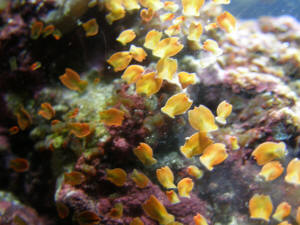
|
|
What Are The Dark Things Coming Out Of My Orange Pink
Ricordea? No One Seems To Know/Corallimorph Health/Systems
6/16/10
Dear Awesome Crew!
<Irina>
Your site is amazing and I've been reading for weeks and
weeks (ok, months!!!). Just can't get enough info crammed
into my little brain but I'm working on it LOL!
<A learning experience for sure.>
I'm hoping someone can identify this dark entity on my new,
orange-pink Ricordea.
I've read copious publications, researched and asked everyone
I can think of, including the shop I got the coral from, what
this "thing" or "things" are; but, to no
avail.
This is the second Ricordea I've bought from the same place.
The first one developed filaments and stressed to death while
expelling a few of these dark-oval or petal-shaped entities along
stringy filaments. This poor creature dissolved in one day.
I'm beginning to think they might be a parasite. Or do
Ricordea poop like this??? I know that sounds silly, but; I truly
don't know and can't find a photo showing anything like
this. I do know it doesn't look like any scat, or poop, that
I know of and I'm stumped.
For size reference sake, the photo below shows the Ricordea open
diameter of barely half an inch. This little guy is now into his
fourth day here and shriveled up to a quarter inch. I'm still
happy to see it at all considering how fast the first one melted
away.
This second one did not let go all kinds of filaments as the
first one did.
Puhleeeez tell me it's not some kind of flatworm.
<Very unlikely. Ricordea have a tendency to extrude their
mesenterial filaments when stressed chemically and/or
mechanically, and I believe this is what you are seeing. Is quite
possible that allelopathy could be responsible if aggressive
corals are kept with them. Your Frogspawn (Euphyllia paradivisa)
is on that list, and when kept together in miniature systems such
as yours, you can expect allelopathy problems in keeping the two
together. Lighting can also come into play here as Ricordea do
not seem to do as well under direct intense light. Bob may have
further input here.>
You have no idea how much I've learned from your wonderful
site and all your efforts are appreciated far more than you will
ever know!
<Is nice to hear this, thank you.>
Respectfully and gratefully,
Irina aka Cranky When Wet
<James (Salty Dog), happy when wet with beer.>
Calgary, Alberta, Canada
Other photos of my hand drawings are below (camera not available
when first Ricordea failed).
<I see, helpful.>
Please see end of email for these.... I express myself better
with my drawings than my writing.
<You're writing is fine.>
TANK INFO: My tanks are tiny: a pico and a Nano.
<Mmmm.>
Main or Nano display is an 8gal Oceanic Biocube
one-inch deep, live sand bed;
Coralia <Koralia> pump;
380gal/hr upgraded filtration pump;
<Waaaay too much, 80-90 would be much better.>
very aged purple Live Rock (stunning);
and the unit is approximately three month's young.
Two Turbo Snails
One lump of Zoanthids
One very large Hawaiian Feather Duster Worm
One Peppermint Shrimp that ate two Aiptasia that appeared on the
worm, above.
Pico is diverse Biotope (six months old)
Polyp/Zoanthid corals, one Frog Spawn
<Ah, the likely culprit if the Ricordea is in with this
Euphyllia.>
and a bit of Small Polyp Encrusting Coral
on a deep, 2.5", sand bed inside a 6gal Fluval Edge modified
tank of 6 gallons.
Two Hermit crabs
(added two LED strips above this first tank and am using a
daylight lamp in order to get higher 6400K white light and some
Actinic as well... My lighting knowledge is poor though I believe
I have a minimum five watts per gallon in that tank.
If prolific wildlife is a clue to success,
<Success in our hobby can be a wide gamut.>
I have what seems like a gazillion copepods; a few bristle worms;
lots of wild dusters, sponges and associated bio-load I cannot
recall the formal name of this second (tunicates sp?) LOL!
I feed Phytofeast algae mix and toss in the occasional intestinal
tract of Maine lobster when the cat doesn't snag it first...
otherwise, the whole thing seems to feed itself and is quite lush
and fascinating. Oh yes, no protein skimmers here so I do weekly,
diligent water changes.
<Great.>
Water condition:
sg = 1.025,
zero nitrite,
zero nitrates,
no ammonia
and pH is 8.2ish.
I don't have the top-of-the-line test kit but did get a
portable refractometer to monitor salinity.
<Another plus, do check the calibration periodically with
distilled water.>
I use a product called "Meersalt" for water
<Not familiar with that product.>
and do weekly water changes of approximately one quart of
buffered-down distilled water (don't have RO system).
The volume/ratio of rock to water is almost 50/50.
I stuffed about fourteen pounds of live rock into this little
tank.
The quarantine tank, is a Pico-style little thing with a simple
filter pump inside it that also breaks water surface a bit. I run
a daylight lamp over it, as well as an array of 30 LED bulbs of
unknown strength (manufacturers don't seem to want to say
what you're buying LOL!). This little unit is barely three
gallons but again is loaded with wildlife like copepods, deep
purple corals and a big, spinning Chaeto-algae ball all grown
from same, original batch of well-cured live rock.
All tanks holding temperatures of 74 - 78 degrees Fahrenheit and
I'm using mini heaters during colder seasons. I hope this is
steady enough for reef systems.
<Be better to adjust the heater to maintain 78 rather than
fluctuate between 74-78. Should be easily done with the summer
temperatures in your area.>
So, if flying by the seat of my pants and a whole lot of
intuition serves me, I think both my little tanks are doing
rather well and are surprisingly stable... for now, hee hee!
<Sounds good with the exception.....>
I know I have a lot to learn and am loving every minute of the
journey!
(I've years of fresh-water experience but little marine and
doing my best).
<I've been into this for 30+ years and I'm still
learning.>
This was the very first Ricordea I purchased. It expelled
filaments and dark "things" within an hour (from top
and side!) and finally dissolved leaving a sad little ring of
tissue on the rock no more than 24 hours
later. I am wondering if those dark entities are some kind of
parasite or disease???
<Unlikely.>
It was a lovely purple with green.... what are those
things???????? Sure hope you can help. Thank you so
much!!!!!!!!!!!!!!!
<As above along with Bob's possible input.> <<I
do concur James. B>>
|
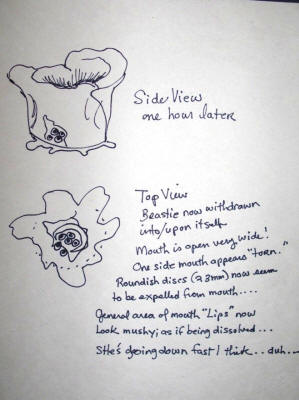 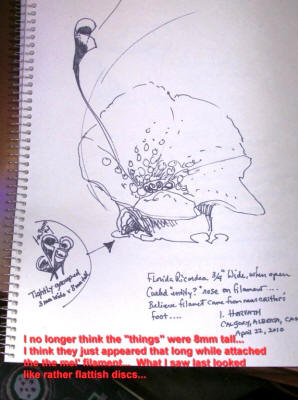
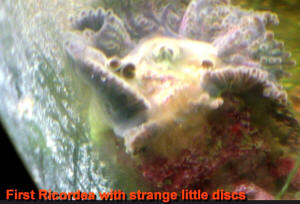 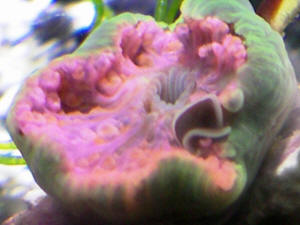 |
Re What Are The Dark Things Coming
Out Of My Orange Pink Ricordea? No One Seems To Know/Corallimorph
Health/Systems 6/16/10
A gazillion thank you's Salty Dog!
<You're welcome.>
My brief replies in bold, teal-colored text below... and spelling
correction: Meersaltz (link below)
<Oh no, please don't do/use that, just reply as you would in
a normal email, the continuation of a thread. Our program does not
display colored text.
Can you please re-send your reply/response as I suggested above.
Makes it too difficult and time consuming to sort through this and
correct. We are not nine to fivers here, are all volunteers
donating one to two hours per day. James (Salty
Dog)><<Well-stated James. B>> |
|
What is This? Harmless Acoel Flatworms --
5/23/10
Crew,
<Hello, Lynn here this evening.>
My son saw these crawling on the glass like little inch worms.
The bulb end expands and stretches out and the two little tails
follow. There were 5 or 6 between 1/16" and 1/4"
long.
<No worries, they're harmless little Acoel flatworms. They
tend to pop up, stick around for a bit, then disappear. For more
information, please see the following links: http://www.wetwebmedia.com/flatworms.htm
http://www.wetwebmedia.com/flatwrmfaq3.htm
>
Thanks
<You're most welcome. Take care, Lynn Z>
|
 |
|
ID???, Flatworm 4/11/10
The green thing under the Magniglass can you tell me what it is
and if it's good or bad I'm seen two other smaller
ones.
<Looks like a flatworm, Convolutriloba retrogemma, to
me.>
I knocked them off the glass with my glass scrubber the other two
disappeared but the other came back and I defiantly saw them move
kinda like a caterpillar or worm.
Thanks for the time
Eric
<See here for more. http://www.wetwebmedia.com/flatworms.htm
.>
<Chris>
|
 |
|
Critter ID 4/2/10
Hello everyone!
<Howdy Rhonda>
I'm almost afraid to ask but I found this weird moving spot
on one of my Alveopora stems. The thing moved pretty fast--there
was about 5 seconds between these photos. Any idea what
you're looking at? Is it horrible?
What should I do?
Thank you a million times.
Rhonda
<Looks to be a flatworm... not horrible if they are few.
Please read here:
http://wetwebmedia.com/flatworms.htm
and the linked Related FAQs files above on "control".
Bob Fenner>
|
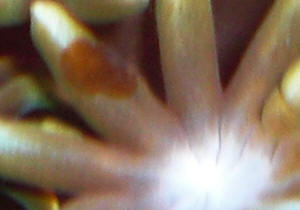 |
Nudibranch hitchhiker 10/12/09
Hello,
<Hi there>
I set up a new 50G tank about 2 months ago after some success (and
failures) with a 14G Nano. As part of the setup, I bought some live
rocks. After the tank was cycled, I saw a black Nudibranch with a thin
blue edge around its body.
<Mmm, though there are many species of Nudibranchs... of many
colour/patterns, I suspect that what you saw/have is actually a
Flatworm.
Please see here for some examples:
http://wetwebmedia.com/flatworms.htm>
I tried to identify from your website and other sources from the
internet, but I am not able to find the a matched photo to ID it. From
its structure, I believe it is of the genus Chromodoris or
Hypselodoris. I
understood that they are carnivores, and they are poisonous. The latter
makes me worry. My tank is not large, and because it is new, there
can't be enough living things for the Nudibranch to feed on. At the
beginning I have some bristle worms and amphipods, I can't see them
any more, may be it is the act of the Nudibranch or the Heniochus. I am
kind of surprise it is still living and wandering around (it
particularly like to stay around the water line), but I think it
won't be able to survive long in the tank because I think the tank
should not have enough food for it. If it dies, then I worry it will
release poisonous stuff and kill the other tank mates.
Is this true? If so, should I remove it before the tank mates get
killed?
<In this volume, 50 gallons... I don't think there is much risk
of this animal poisoning anything>
Thanks in advance,
Simon
<Welcome. Bob Fenner>
Re: Nudibranch hitchhiker... Hey, this guy's
pretty good... 10/12/09
Hi Bob,
Thanks for the quick response. I read the article you pointed below,
yes, it is a flat worm Pseudoceros sapprinus, and sounds like it is a
beneficial animal. I will definition keep it.
Thanks again,
Simon
<Welcome! BobF>
|
Help with identifying unwanted addition in 100 gal
reef aquarium 7/27/09
Hi,
<Scooby doo>
I have exhausted hours online trying to identify what this
particular thing is. I'm referring to the small white flat
ovalish dot on the base of the Frogspawn Coral and also on the
aquarium at the corner behind the Birdsnest Coral.
<I see them...>
We quarantine everything and this appeared just a couple of
months ago. I now see it on the liverock, on our clam's shell
and on the Frogspawn coral that was just added a month ago so it
apparently spreads aggressively.
We have had our tank a couple of years and so far have been
successful adding slowly and quarantining religiously. Please let
me know if you need additional information, I would be happy to
send it.
I need help identifying what this is and how to control it.
Many thanks, Marlyn
<Mmm, need a better resolved, closer up image to make a better
guess, but look to be some sort of Acoel flatworm... Please send
along that better pic
and read here: http://wetwebmedia.com/fltwmcomp.htm
and the linked files above. Bob Fenner>
|
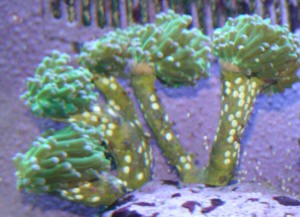 |
|
Identify (Pesky Platyhelminthes)
7/9/09
Hello,
I have been reading your site for years and it has helped me a
lot...thank you. Now for my question, I have something in my
saltwater aquarium. I cant figure out what it could be... It
seems to be a single cell type algae or creature of some
kind...but I've not been able to identify what it could
be.
<Phylum Platyhelminthes:
http://www.wetwebmedia.com/flatworms.htm
>
I need to know if it is harmful to my tank or what?
<Mostly "or what".>
...my tank has been up and running good for about three
years...everything in it seems to be doing just fine.. it has
been in my tank for about a month now but seems to be multiplying
fast and is now starting to cover my glass, live rock and
sand...how do I get rid of it?
<Best physically removed, or via the addition of something
that eats them, though the range of options here will depend on
your aquarium and level of experience; see here:
http://www.wetwebmedia.com/pestflatwrmanthony.htm
http://www.wetwebmedia.com/fltwmcont.htm
>
hope you can help.. I've enclosed 2 picture the first is up
close shot and the second you can see it on my live rock.
<To be honest, I've usually found these pesky flatworms
come and go in pulses, perhaps related to ambient conditions;
optimising water conditions, improving things like skimming,
circulation and filtration, should tilt things in favour of
other, more desirable organisms.>
Thank You
Kristi
<Cheers, Neale.>
|
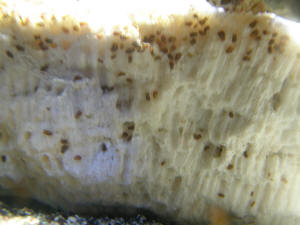  |
|
Critter ID 5/24/09
Sorry crew for the not to informative email. Ok the tank is
saltwater, and the only new additions lately have been orange
mushroom and a chocolate chip starfish
< Chocolate Chip Starfish are not reef safe. The mushroom
could soon become lunch if it or the starfish are not removed.
http://www.wetwebmedia.com/ccstarcompfaqs.htm >
I only was able to get 2 decent pics of this thing on the side of
my tank, but there are about 20 of them that I can see, to much
rock to really see the back of the tank, but there could be more!
Thanks for your help.
Kenny
< The animals in the pics are Red Planaria (Convolutriloba
retrogemma).
Remove what you can. They thrive in high nutrient and low water
flow. Lots of info here on Wet Web. Please read here.
http://www.wetwebmedia.com/pestflatwrmanthony.htm GA Jenkins
>
|
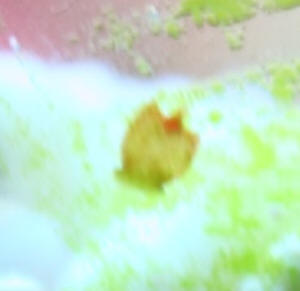
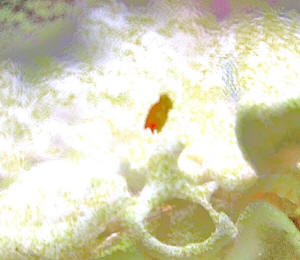 |
|
|

